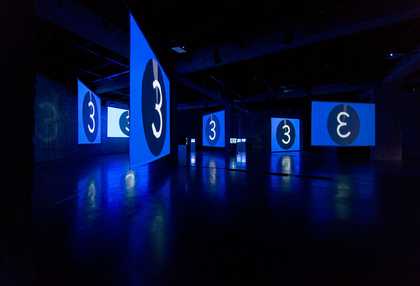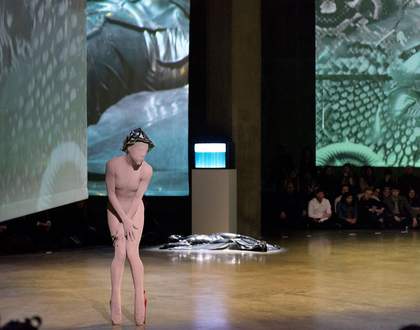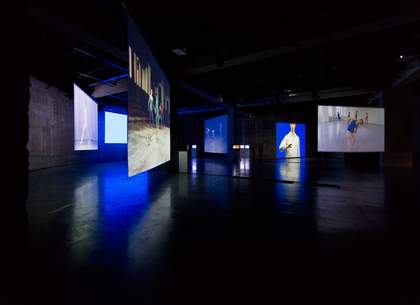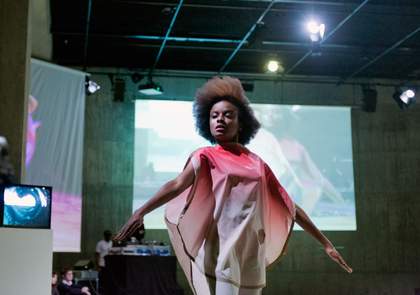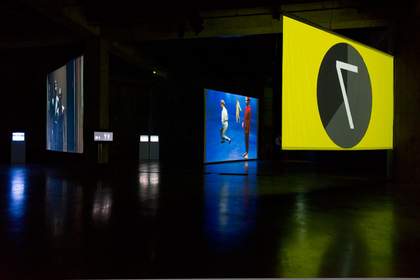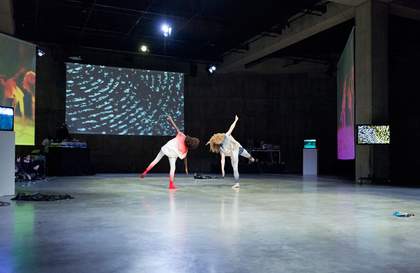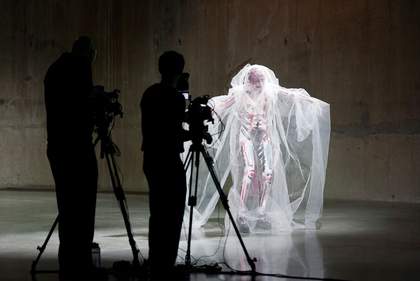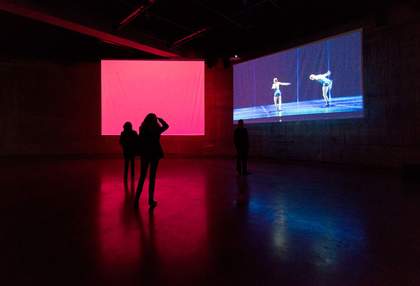Pioneering American video artist and film director Charles Atlas presented his nine-channel video work MC9 in the Tanks at Tate Modern from 28 March to 9 April 2013. The installation comprised nine hanging screens positioned around the space at different angles. Edited videos, primarily resulting from the long-term collaboration between Atlas and American choreographer Merce Cunningham, were projected onto the screens. Atlas was filmmaker-in-residence for Cunningham’s dance company between 1974 and 1983 and they maintained a close working relationship after this period. For MC9, Atlas revisited the material which he and Cunningham generated during the initial collaborative period. The installation also included the final filmed dance piece ever made by Cunningham.
The films reflected the working method Atlas and Cunningham established during their long collaboration, in which the camera came into the choreographic process, rather than remaining separate as an instrument of documentation. Atlas and Cunningham referred to the resultant works as ‘media dances’, meaning dances designed specifically for and with the film apparatus. Neither a dance performance for a live audience, nor a filmmaker’s project designed to witness an autonomous event, these performances brought dance choreography together with video art. The films shown in MC9 reflect this integration of camera and choreography. Sometimes the camera follows a pair of dancers as they move across the landscape, away from the larger group of dancers, and sometimes the camera pulls in tight to one body part, such as the hands. Each of the nine screens showed a different element of choreography, selected and edited by Atlas.
Alongside the video and film installation, a programme of live events featured Atlas’s collaborations with other artists, including dancer Johanna Constantine, musician Helm, and the Paris-based artist duo Cecilia Bengolea and François Chaignaud. For one hour, a group of dancers performed extracts from four works by Bengolea and Chaignaud: Danses Romantiques 2008, Sylphides 2009, (M)IMOSA – Twenty Looks or Paris is Burning at The Judson Church (M) 2011 and altered natives’ Say Yes To Another Excess – TWERK 2012. All of these blended different dance styles and skills. Live music by grime DJs Elijah and Skilliam accompanied these pieces and Atlas live-edited and projected video of the dances onto the screens, replacing the historical footage of Cunningham’s work with the live performances.1 In this way, mediated representations of the dances became part of the live music and choreographic event.
A similar technique was used in Atlas’s collaborative event with Johanna Constantine, with whom Atlas had worked for around twenty years. Constantine’s stark dance piece – which involved metallic body extensions, swathes of fabric and exaggerated make-up – was accompanied by an experimental and abstract soundscape mixed by Helm. Again, Atlas set up a camera to record the dance and used live-editing to manipulate and explore the images and movements created by Constantine, exaggerating the distortions of the dancer’s body already wrought by costume and make-up. The event series Charles Atlas and Collaborators ran from 19 to 25 March 2013, opening to the public not just for the installations and events, but also for rehearsals. The combination of historic work – newly explored through installation – and live collaboration, provided a journey through Atlas’s interdisciplinary process of art making, exploring his use of collaboration as a means of bringing together dance, music, video art and technology.
Acatia Finbow
October 2015

